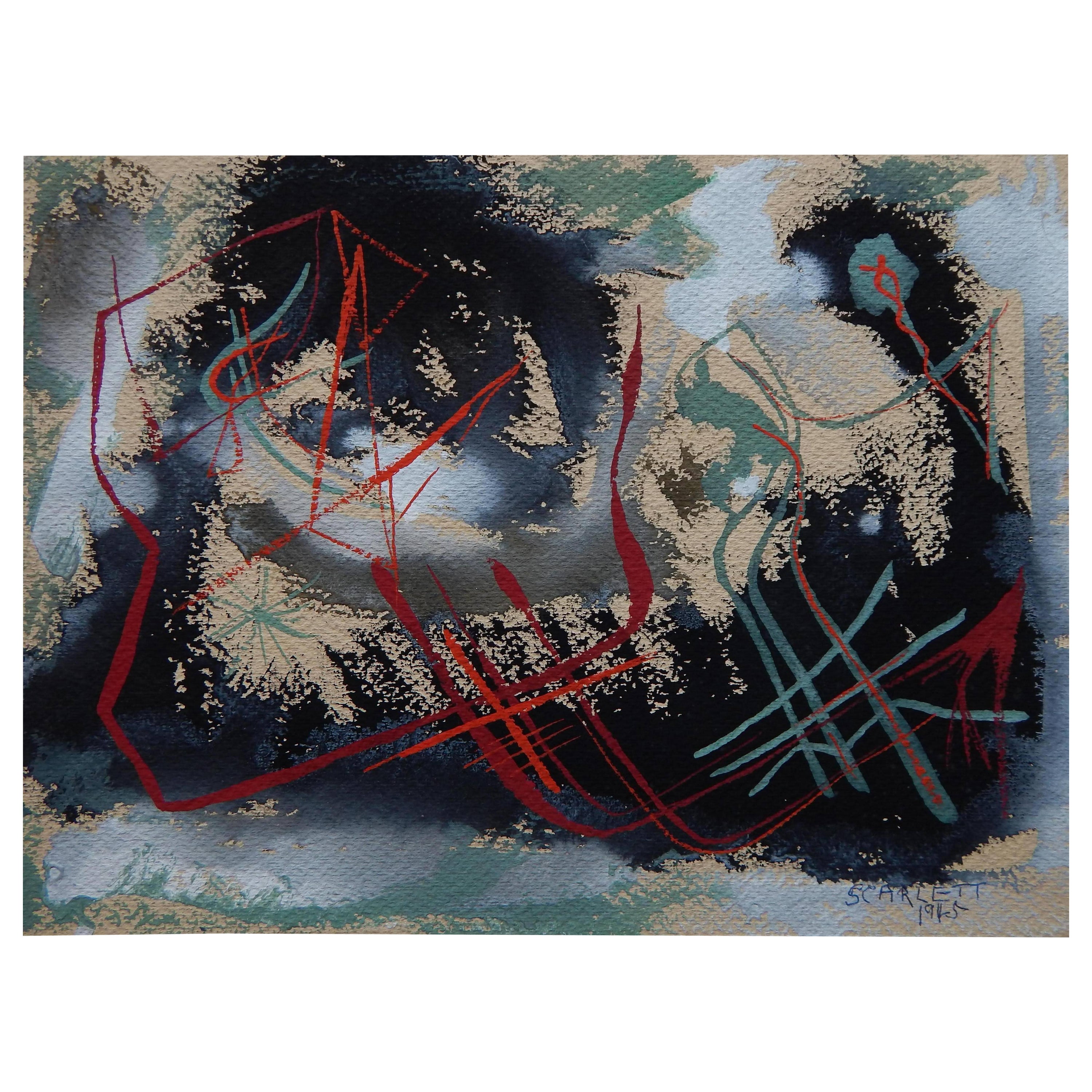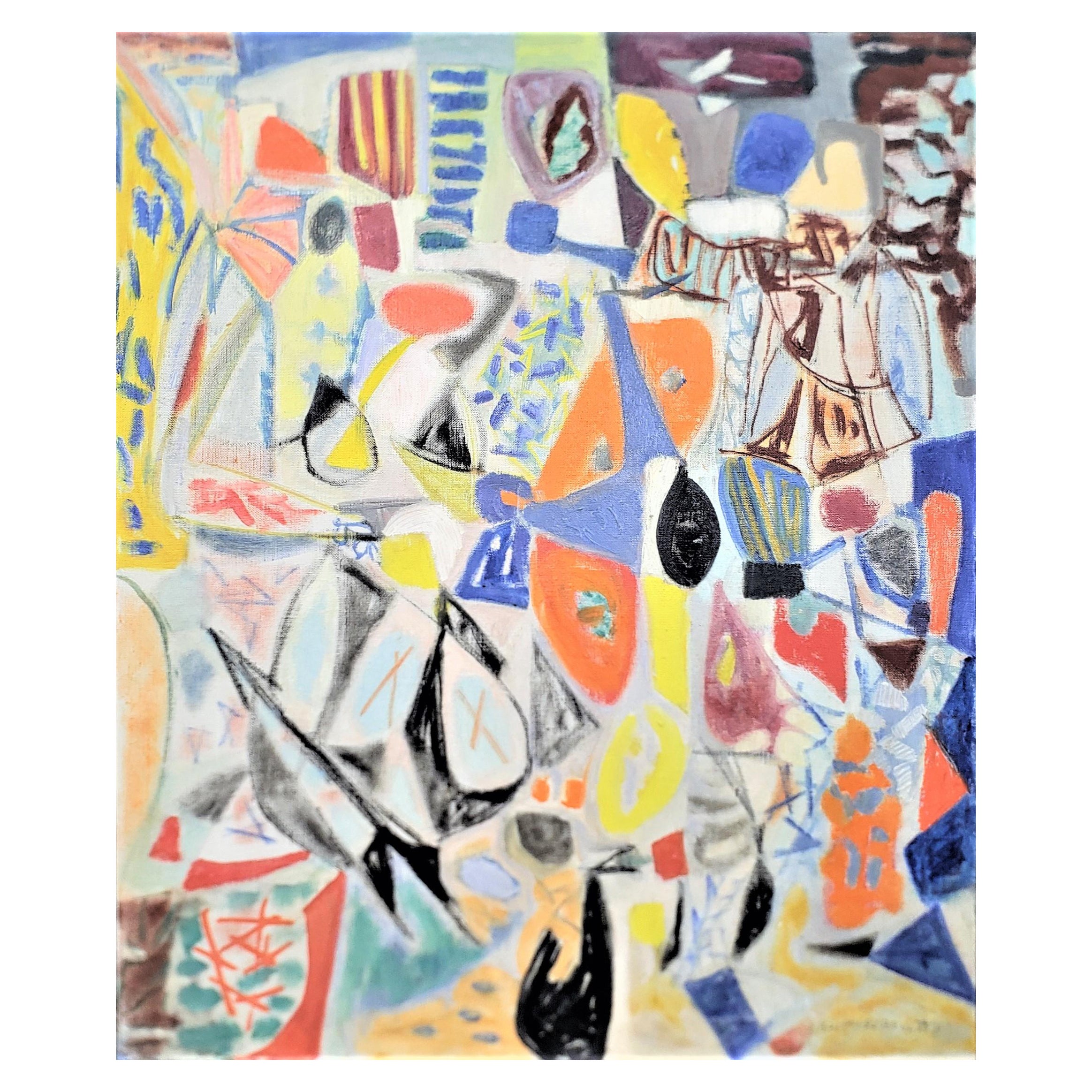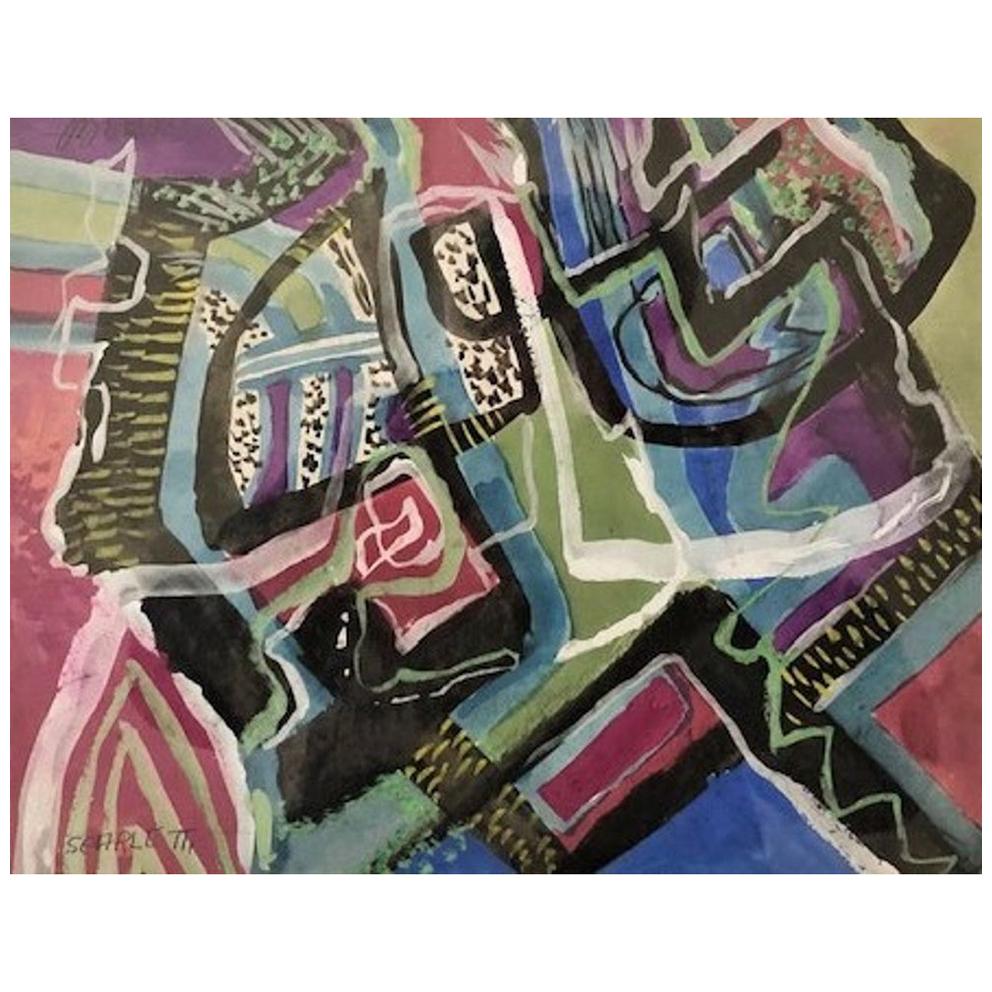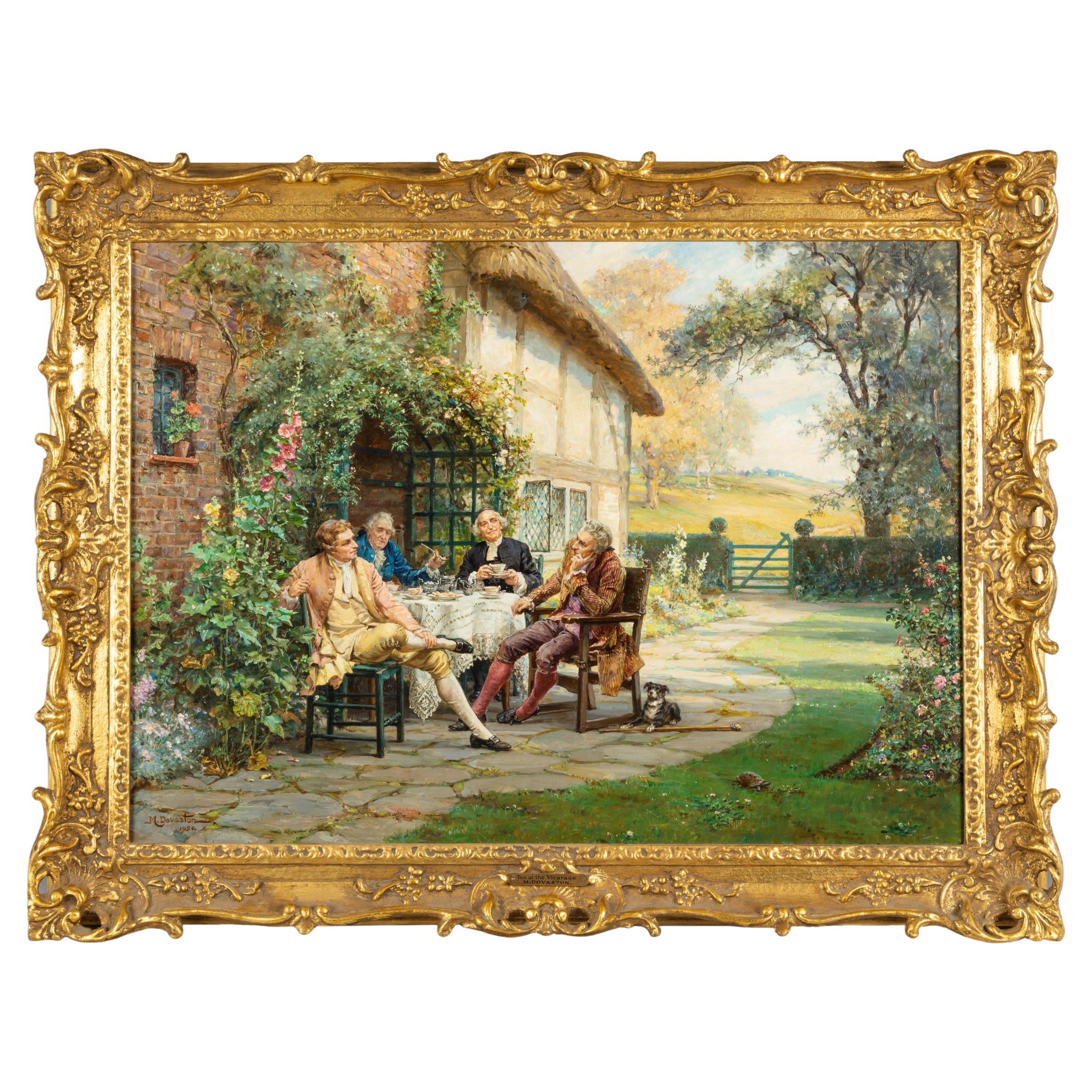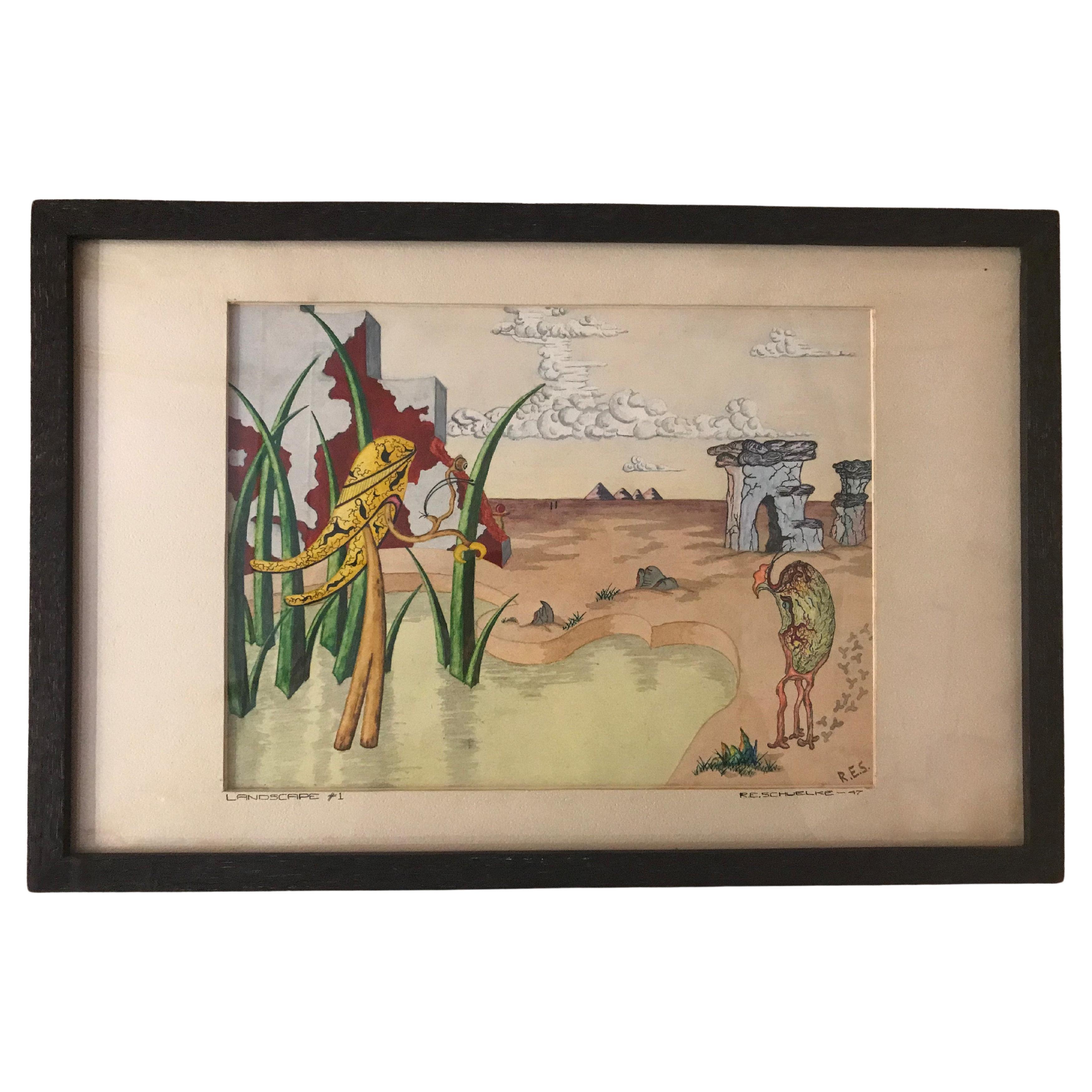Rolph Scarlett Original Watercolor Dated 1952, Geometric Abstraction
About the Item
- Creator:Rolph Scarlett (Artist)
- Dimensions:Height: 24 in (60.96 cm)Width: 27 in (68.58 cm)Depth: 2 in (5.08 cm)
- Style:Mid-Century Modern (Of the Period)
- Materials and Techniques:
- Place of Origin:
- Period:
- Date of Manufacture:1952
- Condition:
- Seller Location:Phoenix, AZ
- Reference Number:
Rolph Scarlett
Rolph Scarlett was a painter of geometric abstraction during the American avant-garde movement of the 1930s and 1940s. Scarlett was born in Guelph, Ontario, Canada in 1889, he left Canada at the age of 18 to go to New York City and returned to Canada during the years of World War I. However, by 1924, Scarlett had established New York City as his home. While he was beginning his career as an abstract painter, he was designing stage scenery for George Bernard Shaw's play, Man and Superman and the Rockettes at Radio City Music Hall. In 1939, while creating the Museum of Non-Objective Painting (later the Solomon R. Guggenheim Museum), Director Hilla Rebay began to take an interest in Scarlett's work. By 1940, he had become the new museum's chief lecturer. By 1953, the Guggenheim owned nearly 60 of his paintings and monoprints. Scarlett later became a resident of the Woodstock art colony for more than 25 years and showed his work in the Woodstock exhibits.
- ShippingRetrieving quote...Ships From: Phoenix, AZ
- Return PolicyA return for this item may be initiated within 14 days of delivery.
- Rolph Scarlett Abstract Expressionist Painting, 1945By Rolph ScarlettLocated in Phoenix, AZAbstract expressionist gouache and watercolor on paper by noted artist Rolph Scarlett - Signed and dated lower right. Archivally matted, unframed. Image size: 11" H x 15" W. In excellent condition. Rolph Scarlett was a painter of geometric abstraction during the American avant-garde movement of the 1930s and 1940s. Born in Guelph, Ontario, Canada in 1889, he left Canada at the age of 18 to go to New York City and returned to Canada during the years of World War I. However, by 1924 he had established New York City as his home. While he was beginning his career as an abstract painter, he was designing stage scenery for George Bernard Shaw...Category
Vintage 1940s American Mid-Century Modern Paintings
MaterialsPaper
- Marcel Gromaire Original Watercolor - Circus ClownBy Marcel GromaireLocated in Phoenix, AZWatercolor on paper by French artist Marcel Gromaire depicting a Circus Clown. The image measures 12"h x 9 7/8"w and the work is in excellent condition. This item is neither matted ...Category
Mid-20th Century Paintings
MaterialsPaint
- Wifredo Lam Cuban Artist Original Watercolor, 1961By Wifredo LamLocated in Phoenix, AZThis original watercolor by Cuban artist Wifredo Lam is in excellent condition and measures 12"h x 10"w. It is signed lower right and dated 1961. It bears a simple gold frame that ...Category
Vintage 1960s Paintings
MaterialsPaint
- Theobald Modespacher Original Watercolor, 1927, Circus SceneBy Theobald ModespacherLocated in Phoenix, AZWonderful deco style original watercolor by listed Swiss artist Theobald Modespacher (1897-1955). The Circus theme painting measures 6"H x 8"W. The frame is 9 3/8"H x 11 3/4"W. Th...Category
Vintage 1920s Swiss Paintings
MaterialsPaint
- Raphael Soyer Original Lithograph/Watercolor, 1955, "The Dancer"By Raphael SoyerLocated in Phoenix, AZRaphael Soyer Original Lithograph - Watercolor added by the artist's hand, 1955 The image measures 13" H x 8 ½" W. Frame measures: 23 1/4"H x 1...Category
Vintage 1950s Paintings
MaterialsPaper
- Noel Leaver Original Watercolor, circa 1920's, Orientalist SubjectBy Noel Harry LeaverLocated in Phoenix, AZWatercolor by British artist Noel Leaver (1889-1951). Beautiful Orientalist subject in excellent condition - framed. Measures: 11" H x 15" W. Frame: 19 3...Category
Vintage 1920s Paintings
MaterialsPaint
- Rolph Scarlett Original Non-Objective Modernist Oil Painting on Canvas: UntitledBy Rolph ScarlettLocated in Hamilton, OntarioThis original painting was done by the well known Canadian-American Rolph Scarlett, dating to approximately 1950 and done in his Non-Objective Modern style. This abstract painting is...Category
Mid-20th Century Canadian Mid-Century Modern Paintings
MaterialsCanvas, Pine
- Rolph Scarlett, Modernist Abstract Composition, Guache on Paper, Ca. 1950’sBy Rolph ScarlettLocated in New York, NYArtist: Rolph Scarletti (Canadian, 1889 – 1984) Object: Modernist Abstract Composition Period: Ca. 1950’s Medium: Guache on paper, framed Dimensions (unframed): Height: 9-1/3” Width: 12” Dimensions (framed): Height: 22-3/4”” Width: 25-3/4” Rolph Scarlett (Canadian, 1889 – 1984) was a consummate explorer of twentieth-century abstract painting. Never afraid of trying new styles, curious and opinionated, constantly engaged with the world around him while steadfastly aware that he was on his own path and his alone, Scarlett more than once proved to be at the artistic zeitgeist of the eras in which he lived. Exposed very early on to the work of Paul Klee through a chance meeting in Europe with the artist himself, Scarlett took up abstraction with a fervor that never diminished during his long and impressive career. To create something that had never existed before: this was Scarlett’s great cause. And that is what is most obvious when you look at Scarlett’s work—you have never seen anything quite like it. Scarlett was Canadian-born, came of age in the Midwest, and spent few important years in Hollywood, where he designed stage sets. His work from this early period echoes Klee’s use of color, his confidence in naïve, primitive forms, and his blend of abstraction and figuration. In its flat spatial qualities it prefigures the Indian Space painting of the 1940s by a decade. He moved to New York in 1933 and eventually found his first great patron at the Museum of Non-Objective Painting, directed by Baroness Hilla Rebay and art patron Solomon R. Guggenheim. Guggenheim would collect over 60 works by Scarlett for his collection, more than any other artist outside of Vasily Kandinsky and Rudolf Bauer. As a frequent exhibitor and lecturer at the Museum of Non-Objective Painting (MNOP), Scarlett honed his sensitive feel for bodies in space and capitalized on his trademark use of bright, vivacious colors into accomplished, perfectly harmonized geometric works. However, Scarlett soon morphed these hard-edged forms into a nuanced expressionistic abstraction which, at its best, seems to be populated by dancing forms that animate the canvases. Along this way he was advised by Rudolf Bauer, the German expatriate and one of the originators of non-objective painting in the teens. Bauer had the idea for the Museum, and Rebay, his champion, had found in Solomon Guggenheim a patron for manifesting it. When Bauer emigrated just before World War II, he wanted to meet Scarlett. The two became friends, and Bauer advised Scarlett on his work over the course of many years. Even in a 1979 interview, Scarlett began to tear up as he recalled his first meeting with Bauer, a man whose work he "worshipped," describing that, "It was a touching moment for me, I’ll tell you." Scarlett and Rebay also had a close, important relationship, one in which he bore the brunt of her sometimes condescending, if motherly, critiques and admonitions with tolerance and gratefulness. Eventually, though, he had to push back. In a letter from 1951 he writes, "I have noticed with growing amazement that during the past three years you have accepted less and less of my work—and, that same work, which you rejected has been accepted and shown in the best and largest shows all over this country." This period—the late 1940s to the early 1950s—did in fact correspond to Scarlett’s most critical success, and to a return to the fanciful forms and characters of his pre-war work. At the same time, he found his own rhythm and complexity using a drip style similar to, though denser and more opaque than, the one made famous by Jackson Pollock, who had worked for many years at the MNOP and with whom he shared common influences. In 1949 he had a very well received solo show in 1949 at the Jacques Seligmann Gallery, reviewed very favorably in The New York Times: "The impression made by these paintings is one of originality and strength." He was also included in a juried show "American Painting Today" at the Metropolitan Museum of Art in 1950 and in the Whitney Annual of 1951. The curator for the Whitney show in fact bypassed a selection of Scarlett’s careful geometrics in favor of a new "lyrical" drip painting—one which he describes as having had "a helluva good time" making. Rebay articulated her loss of control over Scarlett very keenly in one of her last official letters to him: "So your way ended in the horrid jungle it is in now; even a Mr. Pollock’s smearage was not bad enough for you to have a try at; and betraying yourself, you betrayed art and my faith in you, and my present disgrace by my failure to foresee such an outrageous possibility—since you even paint objectively now." Yet, despite the fact that he was moving in his own direction when the change in leadership took place at the Museum of Non-Objective Painting and Rebay was forced out as director, Scarlett was hit hard. He understood this change rightly as a betrayal by the establishment. Scarlett was a unique individual and soul, and was affected personally and philosophically by the idea that the movement with which Scarlett had aligned his talents seemed to disappear overnight, and his life’s work rendered valueless. Without the Museum’s support, Scarlett decided eventually to move to the artists’ community of Shady, New York, just outside of Woodstock. He had occasional shows throughout the years, but mostly settled down to regional obscurity. He began making jewelry, which had been his first trade, and it was following a show of his jewelry in 1975 at the Jaro Gallery, that he was rediscovered by Samuel Esses, and his wife Sandy. Samuel Esses was a successful businessman and an avid collector. He always sought out that which was unusual and, like Scarlett, was ahead of his time in many ways. For example, in 1979, Sam became enthralled with the early graffiti appearing on the New York subway trains. With the sole goal of preserving these groundbreaking yet short lived works of art he was inspired to create "The Esses Studio," a painting warehouse and workshop for graffiti artists to work in a studio, collaborate, and paint on canvas. The biggest names of graffiti writing participated—Futura, Crash, Dondi, Zephyr, and Daze to name a few. The project was well received and provided critical validation at an important time for this alternative form of abstraction to be recognized by the established art world. The success of the "Esses Studio" helped fuel an alternative fire that would propel gallerists and curators to acknowledge other street artists and provide a foundation of acceptance for the early careers of Keith Haring and Jean-Michel Basquiat. It is not a stretch to say that what Esses saw in the graffiti art of the 1970s was very similar to what he saw in 1950s-era Scarletts—something raw, honest, and melding many twentieth century influences into one unique form. Inspired by the importance of the collection and the passion of the collector, Weinstein Gallery...Category
Vintage 1950s Canadian Mid-Century Modern Paintings
MaterialsPaper
- ‘Tea at the Vicarage’ by Margaret Dovaston, Dated 1952By Margaret DovastonLocated in Lymington, Hampshire‘Tea at the Vicarage’ by Margaret Dovaston, dated 1952, an oil painting showing four gentlemen having an earnest conversation over a cup of tea on a terrace outside a cottage garden, Margaret Dovaston, dated 1952. English. Margaret Isabel Dovaston (1884 – 1954) was a British artist who became particularly well known for her historical genre scenes, often depicting groups in Georgian costume. In the course of her education, she was taught by Thomas William Cole at the Ealing School of Art and Arthur Stockdale Cope at the South Kensington School of Art. Her crowning achievement was winning a five-year scholarship the to the Royal Academy Schools (1903-1908) where she won many medals. She exhibited at the Royal Academy (1908 and 1910) and helped set up The Ealing Art...Category
Vintage 1950s English Mid-Century Modern Paintings
MaterialsPaint
- Original WatercolorLocated in Chicago, ILJust a very nice clean original watercolor, that is signed, but we could not find any information on the artist.Category
Vintage 1950s American Paintings
- Surrealist Landscape Watercolor Signed R. E. Schwelke and Dated 1947By R.E. SchwelkeLocated in Pasadena, CAFramed colorful surrealist watercolor, signed by artist R.E. Schwelke in 1947. Titled "Landscape #1". Dark stained frame.Category
Vintage 1940s American Mid-Century Modern Paintings
MaterialsPaint, Wood
- Watercolor Painting of the Bellerophon, Dated 1855Located in Downingtown, PAThe large watercolor picture depicts the Bellerophon sailing out to sea past South Sea Castle off Spithead. Figures can be seen on board. She flies the Blue Ensign, a Union Jack and the Royal Standard. South Sea Castle is to her left and land with a row of houses on the right. An inscription below reads: The Bellerophon 74 Sailing OFF South Sea Castle 1855 Bellerophon: A Greek hero who, with the help of the winged horse Pegasus slew the monster Chimaera Bellerophon: "Common" 74 gun 3rd Rate. Based on HMS Dublin of 1755, a total of 14 ships of the Bellerophon class were built, and a total of 93 "Common" class vessels were built in all. Mr Timothy Akers MA, B.Sc (Hon's) Maritime Research Archaeologist. An Account of the Fitting out of H.M.S. "Bellerophon." This affords a brilliant example of what can be done in the Navy, when a ship's company are commanded by officers possessing the requisite union of due seamanlike and administrative qualities, and I give it as a high standard by which all such may be measured, and as an appropriate pendant to the first section of our subject. On March 7th, 1847, orders were unexpectedly received for the 90-gun ships "Rodney", Captain Edward Collier...Category
Antique Mid-19th Century English Early Victorian Paintings
MaterialsPaper
